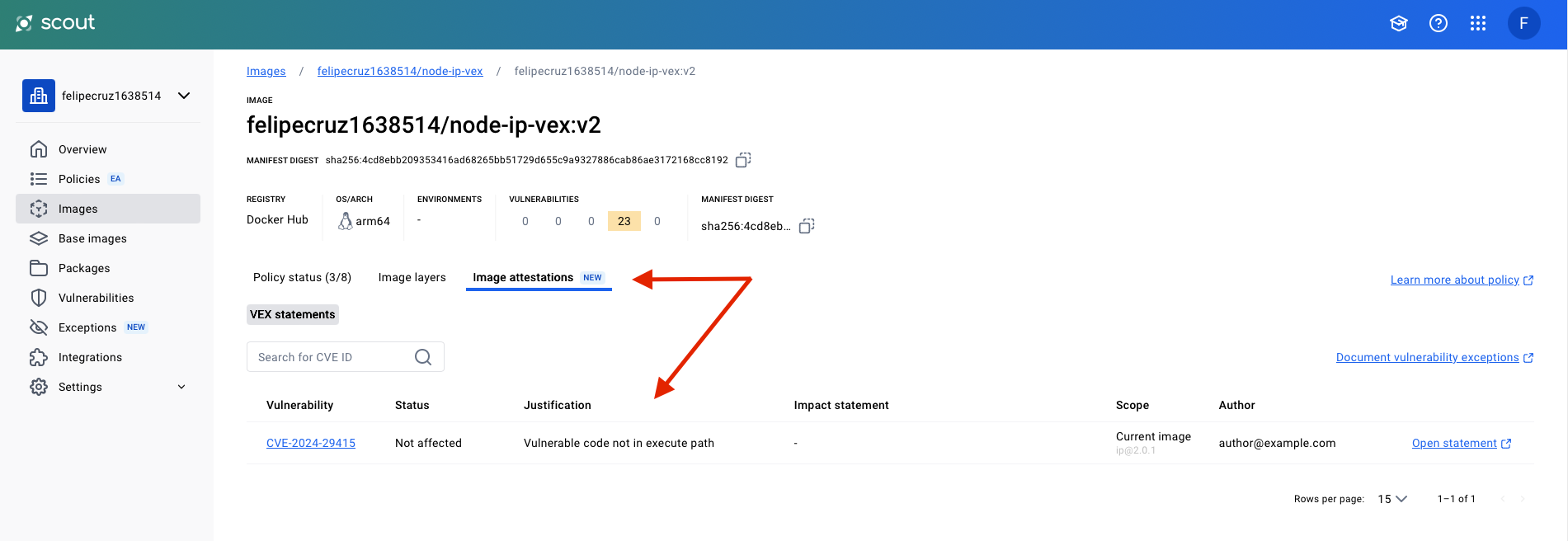This sample project depends on the node-ip npm package which is vulnerable to CVE-2024-29415.
However, because our project does not directly use the vulnerable function .isPublic(), it is not exploitable to CVE-2024-29415.
I can package my project as a Docker image:
docker buildx build -t felipecruz1638514/node-ip-vex:v1 .And run a Docker Scout analysis to check if my project is vulnerable to CVE-2024-29415:
docker scout cves felipecruz1638514/node-ip-vex:v1 --only-cve-id CVE-2024-29415
✓ Image stored for indexing
✓ Indexed 221 packages
✓ Provenance obtained from attestation
✗ Detected 1 vulnerable package with 1 vulnerability
## Overview
│ Analyzed Image
────────────────────┼─────────────────────────────────────
Target │ felipecruz1638514/node-ip-vex:v1
digest │ 972354a74233
platform │ linux/arm64
vulnerabilities │ 0C 1H 0M 0L
size │ 48 MB
packages │ 221
## Packages and Vulnerabilities
0C 1H 0M 0L ip 2.0.1
pkg:npm/ip@2.0.1
✗ HIGH CVE-2024-29415 [Server-Side Request Forgery (SSRF)]
https://scout.docker.com/v/CVE-2024-29415
Affected range : <=2.0.1
Fixed version : not fixed
1 vulnerability found in 1 package
LOW 0
MEDIUM 0
HIGH 1
CRITICAL 0The output from this command shows that this CVE affects the npm package ip@2.0.1 in the image.
The next step is to generate a VEX document to add context about the fact that just because it contains a vulnerable package - ip@2.0.1 - it does not mean that the vulnerability is exploitable to CVE-2024-29415.
We can use vexctl to create a VEX document:
vexctl create \
--author="author@example.com" \
--product="pkg:docker/felipecruz1638514/node-ip-vex@v2" \
--subcomponents="pkg:npm/ip@2.0.1" \
--vuln="CVE-2024-29415" \
--status="not_affected" \
--justification="vulnerable_code_not_in_execute_path" \
--file="CVE-2024-29415.vex.json"To test whether the CVE has been suppressed, we can build the image again under a new tag (v2) and copy the VEX statement into the image filesystem. That step is already covered using the COPY . . in the existing Dockerfile.
docker buildx build -t felipecruz1638514/node-ip-vex:v2 .Next, run the Docker Scout analysis again loading the VEX document:
docker scout cves felipecruz1638514/node-ip-vex:v2 --only-cve-id CVE-2024-29415 --vex-location .
✓ Image stored for indexing
✓ Indexed 324 packages
✓ Loaded 1 VEX document
✗ Detected 1 vulnerable package with 1 vulnerability
## Overview
│ Analyzed Image
────────────────────┼─────────────────────────────────────
Target │ felipecruz1638514/node-ip-vex:v2
digest │ 646daafacd8e
platform │ linux/arm64
vulnerabilities │ 0C 1H 0M 0L
size │ 76 MB
packages │ 324
## Packages and Vulnerabilities
0C 1H 0M 0L ip 2.0.1
pkg:npm/ip@2.0.1
✗ HIGH CVE-2024-29415 [Server-Side Request Forgery (SSRF)]
https://scout.docker.com/v/CVE-2024-29415
Affected range : <=2.0.1
Fixed version : not fixed
VEX : not affected [vulnerable code not in execute path]
: author@example.com
1 vulnerability found in 1 package
LOW 0
MEDIUM 0
HIGH 1
CRITICAL 0 Notice in the output above that CVE-2024-29415 has been suppressed:
VEX : not affected [vulnerable code not in execute path]
: author@example.com
Also, you can use the --only-vex-affected flag to filter out the suppressed CVE:
docker scout cves felipecruz1638514/node-ip-vex:v2 --only-cve-id CVE-2024-29415 --vex-location . --only-vex-affected
✓ SBOM of image already cached, 324 packages indexed
✓ Loaded 1 VEX document
✓ No vulnerable package detected
## Overview
│ Analyzed Image
────────────────────┼─────────────────────────────────────
Target │ felipecruz1638514/node-ip-vex:v2
digest │ 646daafacd8e
platform │ linux/arm64
vulnerabilities │ 0C 0H 0M 0L
size │ 76 MB
packages │ 324
Finally, let's push the image to Docker Scout (scout.docker.com) and inspect it in the UI:
docker buildx build --sbom=false --provenance=false -t felipecruz1638514/node-ip-vex:v2 --push .Note: VEX documents embedded in the image filesystem are not considered for images that have attestations. If your image has any attestations, Docker Scout will only look for exceptions in the attestations, and not in the image filesystem. That's why we disabled the SBOM and provenance in the
docker buildx buildcommand.
In the Docker Scout website the v2 tag doesn't show the CVE-2024-29415 vulnerability with HIGH severity anymore as Scout takes into account the VEX document embedded in the image filesystem.
On the image details page, we can see the VEX document that was loaded from the image filesystem:

